Trends and Evolution of Research on Women’s Entrepreneurship and Communication in the Scientific Literature
Abstract
1. Introduction
- To analyze the main lines of research in the scientific literature on female entrepreneurship and communication.
- To offer a summary of the research activity on female entrepreneurship and communication in terms of volume of work, evolution over time and trends.
- Identify and graphically represent the most prevalent topics in scientific publications, as well as the most influential authors in the international scene, their main affiliations and how they are interrelated.
- Detect geographic areas where the greatest production is generated and those quality scientific journals that contain the greatest number of publications on the subject under study.
2. Materials and Methods
3. Results
3.1. Keywords Analysis
3.2. Authorsip Analysis
3.3. Analysis of Main Co-Authorships—Countries/Organizations and Number of Records
4. Discussion
5. Conclusions
Author Contributions
Funding
Data Availability Statement
Conflicts of Interest
Appendix A
| Clusters | Terms |
|---|---|
| 1 | Big data analytics; care; competitiveness; data mining; decision-making; Europe; female leadership; ict; innovation; knowledge; Malaysia; marketing; migration; opportunity recognition; organizational performance; pls-sem; policies; productivity; risk; rural; service quality; small and medium enterprises; social capital; supply chain management; typology, UAE; unemployment; Vietnam |
| 2 | Benefits; career success; challenges; critical success factors; culture; growth; hospitality; legitimacy; liminality management; Middle East; motivation; performance; religion; Russia; South Africa; stem; stereotypes; sub-Saharan Africa; support; United Arab Emirates; women entrepreneurship |
| 3 | Agriculture; discourse; emancipation; empowerment; ethnography; family firms; gender; homeworking; Indonesia; Instagram; Ireland; Jordan; Kuwait; leadership; literature review; Palestine; power; resistance; self-employment; social change; strategy; Uganda |
| 4 | Bangladesh; banks; china; covid-19: customer satisfaction; e-commerce; family support; firm performance; glass ceiling; learning; locus of control; open innovation; patriarchy; private sector; role models; Saudi Arabia; structural equation modeling; students; theory of planned behavior; tourism; work-life-balance |
| 5 | Adoption; attitude; Cameroon; consumer behavior; context; embeddedness; hegemonic masculinity; hegemony; information and communication; intention; Islam; Lebanon; media; Mena; perceived usefulness; purchase intention; reciprocity; satisfaction; social networks; tam; trust |
| 6 | Agency; artificial intelligence; bibliometric analysis; blockchain; crowdfunding; discrimination; fintech; immigrants; India, integration; intervention; intimate partner violence; Japan; mental health; mobile applications; prevention; quality of life; refugees; startup |
| 7 | Analytic hierarchy process; business development; corporate entrepreneurship; e-business; family business; human capital; intellectual capital; intrapreneurship; Iran; qualitative research; relational capital; resources; smartphone adoption; systematic literature review; training; value creation |
| 8 | Creativity; enterprise; family; feminism; identity; masculinity; motherhood; mumpreneur; narrative analysis; neoliberalism; networks; Pakistan; review; self-employed; youth |
| 9 | Africa; business; commitment; employment; fear of failure; Ghana; human resource management; microenterprise; Nigeria; opportunity; resilience; rural women; self-efficacy; social inclusion; success |
| 10 | Barriers; collectivism; development; economy; globalization; human development; internet; Latin America; Oman; poverty; stress; Turkey; well-being |
| 11 | Commercial entrepreneurship; England; enterprise culture; enterprise development; entrepreneurship; global entrepreneurship monitor; informal sector; logistic regression; Sweden; tax compliance; Ukraine; underground sector. |
| 12 | Academic entrepreneurship; capital; characteristics; developing countries; finance; institutions; intersectionality; race; social; Tanzania; venture capital |
| 13 | Afghanistan; corporate social responsibility; emerging economy; ethics; Greece; green marketing; mentoring; sustainability; United Kingdom; women |
| 14 | Age; digitalization; e-learning; education; experience; Serbia; skill development; university |
| 15 | Communication; content analysis; Ethiopia; mixed methods; social media; twitter; women empowerment |
| 16 | Bricolage; demographic characteristics; technology |
References
- Aggarwal, Monika, and Ramanjit Kaur Johal. 2021. Rural Women Entrepreneurship: A Systematic Literature Review and Beyond. World Journal of Science, Technology and Sustainable Development 18: 373–92. [Google Scholar] [CrossRef]
- Ahl, Helene, and Susan Marlow. 2012. Exploring the Dynamics of Gender, Feminism and Entrepreneurship: Advancing Debate to Escape a Dead End? Organization 19: 543–62. [Google Scholar] [CrossRef]
- Ahl, Helene, and Teresa Nelson. 2015. How Policy Positions Women Entrepreneurs: A Comparative Analysis of State Discourse in Sweden and the United States. Journal of Business Venturing 30: 273–91. [Google Scholar] [CrossRef]
- Al-Dajani, Haya, and Susan Marlow. 2013. Empowerment and Entrepreneurship: A Theoretical Framework. Edited by Dr Julia Rouse, Lorna Treanor and Dr Emma Fleck. International Journal of Entrepreneurial Behaviour & Research 19: 503–24. [Google Scholar] [CrossRef]
- Anderson, Alistair, John Park, and Sarah Jack. 2007. Entrepreneurial Social Capital: Conceptualizing Social Capital in New High-Tech Firms. International Small Business Journal: Researching Entrepreneurship 25: 245–72. [Google Scholar] [CrossRef]
- Aramand, Majid. 2012. Women Entrepreneurship in Mongolia: The Role of Culture on Entrepreneurial Motivation. Equality, Diversity and Inclusion: An International Journal 32: 68–82. [Google Scholar] [CrossRef]
- Bao, Ligao, Motoi Kusadokoro, Atsushi Chitose, and Chuangbin Chen. 2023. Development of Socially Sustainable Transport Research: A Bibliometric and Visualization Analysis. Travel Behaviour and Society 30: 60–73. [Google Scholar] [CrossRef]
- Blažun Vošner, Helena, Samo Bobek, Simona Sternad Zabukovšek, and Peter Kokol. 2017. Openness and Information Technology: A Bibliometric Analysis of Literature Production. Kybernetes 46: 750–66. [Google Scholar] [CrossRef]
- Brooks, Alison Wood, Laura Huang, Sarah Wood Kearney, and Fiona E. Murray. 2014. Investors Prefer Entrepreneurial Ventures Pitched by Attractive Men. Proceedings of the National Academy of Sciences 111: 4427–31. [Google Scholar] [CrossRef]
- Datta, Punita Bhatt, and Robert Gailey. 2012. Empowering Women through Social Entrepreneurship: Case Study of a Women’s Cooperative in India. Entrepreneurship Theory and Practice 36: 569–87. [Google Scholar] [CrossRef]
- de las Heras-Pedrosa, Carlos, Carmen Jambrino-Maldonado, Dolores Rando-Cueto, and Patricia P. Iglesias-Sánchez. 2022. COVID-19 Study on Scientific Articles in Health Communication: A Science Mapping Analysis in Web of Science. International Journal of Environmental Research and Public Health 19: 1705. [Google Scholar] [CrossRef]
- De Vita, Luisa, Michela Mari, and Sara Poggesi. 2014. Women Entrepreneurs in and from Developing Countries: Evidences from the Literature. European Management Journal 32: 451–60. [Google Scholar] [CrossRef]
- Durkin, Mark, Pauric McGowan, and Niall McKeown. 2013. Exploring Social Media Adoption in Small to Medium-Sized Enterprises in Ireland. Journal of Small Business and Enterprise Development 20: 716–34. [Google Scholar] [CrossRef]
- Dy, Angela Martinez, Susan Marlow, and Lee Martin. 2017. A Web of Opportunity or the Same Old Story? Women Digital Entrepreneurs and Intersectionality Theory. Human Relations 70: 286–311. [Google Scholar] [CrossRef]
- Ebrahimi, Ramin, Shahla Choobchian, Homayoun Farhadian, Imaneh Goli, Ebrahim Farmandeh, and Hossein Azadi. 2022. Investigating the Effect of Vocational Education and Training on Rural Women’s Empowerment. Humanities and Social Sciences Communications 9: 167. [Google Scholar] [CrossRef]
- Ellegaard, Ole. 2018. The Application of Bibliometric Analysis: Disciplinary and User Aspects. Scientometrics 116: 181–202. [Google Scholar] [CrossRef]
- Ellegaard, Ole, and Johan A. Wallin. 2015. The Bibliometric Analysis of Scholarly Production: How Great Is the Impact? Scientometrics 105: 1809–31. [Google Scholar] [CrossRef]
- Estrin, Saul, Julia Korosteleva, and Tomasz Mickiewicz. 2013. Which Institutions Encourage Entrepreneurial Growth Aspirations? Journal of Business Venturing 28: 564–80. [Google Scholar] [CrossRef]
- Gálvez, Carmen. 2016. Visualización de Las Principales Líneas de Investigación En Salud Pública: Un Análisis Basado En Mapas Bibliométricos Aplicados a La Revista Española de Salud Pública (2006–2015). Revista Española de Salud Pública 90: e40028. [Google Scholar]
- Garcia, André Spuri, and Daniela Meirelles Andrade. 2022. O Campo de Pesquisas Do Empreendedorismo: Transformações, Padrões e Tendências Na Literatura Científica (1990–2019). Revista Brasileira de Inovação 21: e022002. [Google Scholar] [CrossRef]
- Global Entrepreneurship Research Association. 2021. Global Entrepreneurship Monitor. Women’s Entrepreneurship 2020/21: Thriving Through Crisis. London: London Business School. [Google Scholar]
- Godwin, Lindsey N., Christopher E. Stevens, and Nurete L. Brenner. 2006. Forced to Play by the Rules? Theorizing How Mixed–Sex Founding Teams Benefit Women Entrepreneurs in Male–Dominated Contexts. Entrepreneurship Theory and Practice 30: 623–42. [Google Scholar] [CrossRef]
- González-Ros, Ana. 2021. Comunicación Integrada de Marketing En Nicaragua. Análisis Comparativo de Los Emprendimientos Femeninos Del Sector Moda. Revista Mediterránea de Comunicación 12: 263. [Google Scholar] [CrossRef]
- Greenberg, Jason, and Ethan Mollick. 2017. Activist Choice Homophily and the Crowdfunding of Female Founders. Administrative Science Quarterly 62: 341–74. [Google Scholar] [CrossRef]
- Güney-Frahm, Irem. 2018. A New Era for Women? Some Reflections on Blind Spots of ICT-Based Development Projects for Women’s Entrepreneurship and Empowerment. Gender, Technology and Development 22: 130–44. [Google Scholar] [CrossRef]
- Guo, Qing, Siyu Chen, and Xiangquan Zeng. 2021. Does Fintech Narrow the Gender Wage Gap? Evidence from China. China & World Economy 29: 142–66. [Google Scholar] [CrossRef]
- Henry, Colette, Lene Foss, and Helene Ahl. 2016. Gender and Entrepreneurship Research: A Review of Methodological Approaches. International Small Business Journal: Researching Entrepreneurship 34: 217–41. [Google Scholar] [CrossRef]
- Huang, Qin, and Furong Liu. 2019. International translation studies from 2014 to 2018: A bibliometric analysis and its implications. Translation Review 105: 34–57. [Google Scholar] [CrossRef]
- Iglesias-Sánchez Patricia, P., and Carmen Jambrino. 2018. Diagnóstico de Emprendimiento Femenino en la Provincia de Málaga. Málaga: Diputación de Málaga. [Google Scholar]
- Jose, Saju. 2018. Strategic Use of Digital Promotion Strategies among Female Emigrant Entrepreneurs in UAE. International Journal of Emerging Markets 13: 1699–718. [Google Scholar] [CrossRef]
- Kitchenham, Barbara, and Stuart Charters. 2007. Guidelines for Performing Systematic Literature Reviews in Software Engineering, Technical Report EBSE 2007-001. Keele University and Durham University Joint Report. Newcastle: Keele University, pp. 1–57. [Google Scholar]
- Lafuente, Esteban, Yancy Vaillant, and Josep Rialp. 2007. Regional Differences in the Influence of Role Models: Comparing the Entrepreneurial Process of Rural Catalonia. Regional Studies 41: 779–96. [Google Scholar] [CrossRef]
- Maksimović, Goran, Tatjana Ivanović, and Aleksandra Vujko. 2019. Self-Employment of Women through Associations in the Rural Areas of Sirinicka Zupa. Ekonomika Poljoprivrede 66: 251–63. [Google Scholar] [CrossRef]
- Martínez, M. A., M. Herrera, E. Contreras, A. Ruíz, and E. Herrera-Viedma. 2015. Characterizing Highly Cited Papers in Social Work through H-Classics. Scientometrics 102: 1713–29. [Google Scholar] [CrossRef]
- Mazhar, Saman, Ali Sher, Azhar Abbas, Abdul Ghafoor, and Guanghua Lin. 2022. Empowering Shepreneurs to Achieve the Sustainable Development Goals: Exploring the Impact of Interest-free Start-up Credit, Skill Development and ICTS Use on Entrepreneurial Drive. Sustainable Development. [Google Scholar] [CrossRef]
- Mitchelmore, Siwan, and Jennifer Rowley. 2013. Entrepreneurial Competencies of Women Entrepreneurs Pursuing Business Growth. Journal of Small Business and Enterprise Development 20: 125–42. [Google Scholar] [CrossRef]
- Moya-Clemente, Ismael, Gabriela Ribes-Giner, and Joana Carolina Chaves-Vargas. 2021. Sustainable Entrepreneurship: And Approach from Bibliometric Analysis. Journal of Business Economics and Management 22: 297–319. [Google Scholar] [CrossRef]
- Olsson, Anna Karin, and Iréne Bernhard. 2021. Keeping up the Pace of Digitalization in Small Businesses–Women Entrepreneurs’ Knowledge and Use of Social Media. International Journal of Entrepreneurial Behavior & Research 27: 378–96. [Google Scholar] [CrossRef]
- Overå, Ragnhild. 2006. Networks, Distance, and Trust: Telecommunications Development and Changing Trading Practices in Ghana. World Development 34: 1301–15. [Google Scholar] [CrossRef]
- Phoong, Seuk Wai, Seuk Yen Phoong, and Shi Ling Khek. 2022. Systematic Literature Review With Bibliometric Analysis on Markov Switching Model: Methods and Applications. SAGE Open 12: 215824402210930. [Google Scholar] [CrossRef]
- Ramírez, Cabeza, Luis Javier, Sandra Sánchez Cañizares, University of Cordoba, Fernando Fuentes García, and University of Cordoba. 2017. Entrepreneurship as a Dynamic Field of Study: A Bibliometric Analysis of Research Output. Tourism & Management Studies 13: 59–71. [Google Scholar] [CrossRef]
- Rosa, Peter, and Alison Dawson. 2006. Gender and the Commercialization of University Science: Academic Founders of Spinout Companies. Entrepreneurship & Regional Development 18: 341–66. [Google Scholar] [CrossRef]
- Sampaio, Carlos, Luís Farinha, João Renato Sebastião, and António Fernandes. 2022. Putting the Magnifying Glass on Minorities Groups in Entrepreneurship: What Can We Observe? Strategic Change 31: 367–86. [Google Scholar] [CrossRef]
- Sánchez, Elba Patricia Benavides, Ismael Moya-Clemente, and Gabriela Rives-Giner. 2021. Sustainable Entrepreneurship and Sustainable Development Goals: A Bibliometric Analysis. Tec Empresarial 16: 101–22. [Google Scholar]
- Sánchez, Marcelo Sánchez-Oro, and María Rosa Fernández Sánchez. 2017. Digital Technologies and Rural Women’s Entrepreneurship. Prisma Social 18: 260–77. [Google Scholar]
- Sanchez-Nunez, Pablo, Manuel J. Cobo, Carlos de las Heras-Pedrosa, Jose Ignacio Pelaez, and Enrique Herrera-Viedma. 2020. Opinion Mining, Sentiment Analysis and Emotion Understanding in Advertising: A Bibliometric Analysis. IEEE Access 8: 134563–76. [Google Scholar] [CrossRef]
- Santos, Francisco J., Muhammad Azam Roomi, and Francisco Liñán. 2016. About Gender Differences and the Social Environment in the Development of Entrepreneurial Intentions. Journal of Small Business Management 54: 49–66. [Google Scholar] [CrossRef]
- Shinnar, Rachel S., Olivier Giacomin, and Frank Janssen. 2012. Entrepreneurial Perceptions and Intentions: The Role of Gender and Culture. Entrepreneurship Theory and Practice 36: 465–93. [Google Scholar] [CrossRef]
- Tanti, Dewi Sad, Robert Jeyakumar Nathan, Ponco Budi Sulistyo, Soekmawati, Farah Hanim, and Viviantie Sarjuni. 2021. Empowering Cross-Border Women Entrepreneurs via Mobile ICT: Framework for Malaysian and Indonesian Women-Led MSMES. Journal of Nusantara Studies (JONUS) 6: 340–57. [Google Scholar] [CrossRef]
- Tovmasyan, Gayane. 2022. Promoting Female Entrepreneurship in Tourism for Sustainable Development. Marketing and Management of Innovations 1: 18–36. [Google Scholar] [CrossRef]
- Ülker, Pembe, Mustafa Ülker, and Kurtuluş Karamustafa. 2022. Bibliometric Analysis of Bibliometric Studies in the Field of Tourism and Hospitality. Journal of Hospitality and Tourism Insights. [Google Scholar] [CrossRef]
- United Nations Statistics Division (UNSD). 2022. The Sustainable Development Goals Report 2020. New York: Department of Economic and Social Affairs. United Nations Publications. Available online: https://unstats.un.org/sdgs/report/2020/The-Sustainable-Development-Goals-Report-2020.pdf (accessed on 16 September 2022).
- van Eck, Nees Jan, and Ludo Waltman. 2010. Software Survey: VOSviewer, a Computer Program for Bibliometric Mapping. Scientometrics 84: 523–38. [Google Scholar] [CrossRef] [PubMed]
- Wang, Jing, Yaokuang Li, and Dan Long. 2019. Gender Gap in Entrepreneurial Growth Ambition: The Role of Culturally Contingent Perceptions of the Institutional Environment in China. International Journal of Entrepreneurial Behavior & Research 25: 1283–307. [Google Scholar] [CrossRef]
- Williams, Colin C., and Sara Nadin. 2010. Entrepreneurship and the Informal Economy: An Overview. Journal of Developmental Entrepreneurship 15: 361–78. [Google Scholar] [CrossRef]
- Williams, Sean D., Gisela Ammetller, Inma Rodriguez-Ardura, and Xiaoli Li. 2020. Narratives of International Women Entrepreneurs: An Exploratory Case Study of Identity Negotiation in Technology Startups. IEEE Transactions on Professional Communication 63: 39–51. [Google Scholar] [CrossRef]
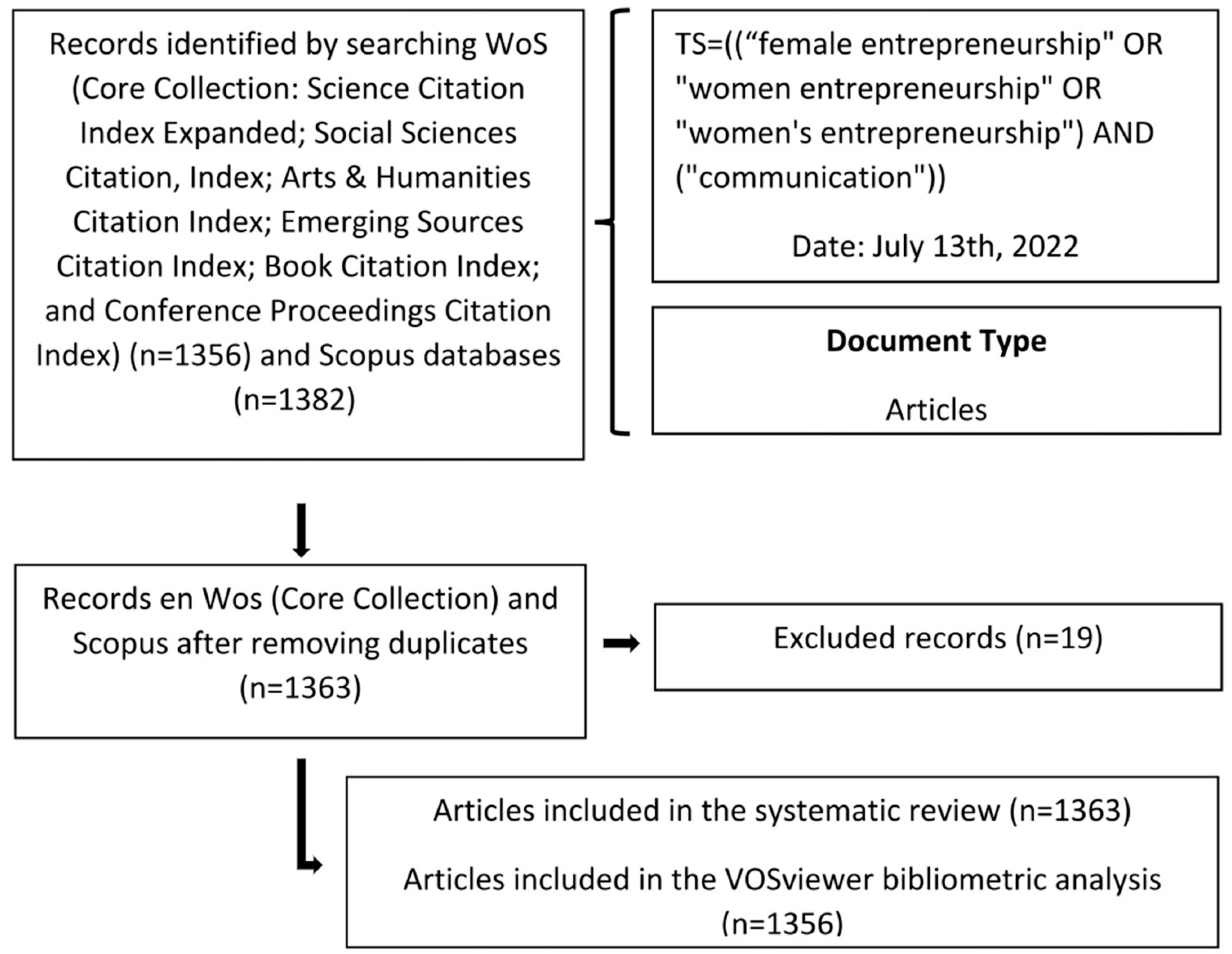


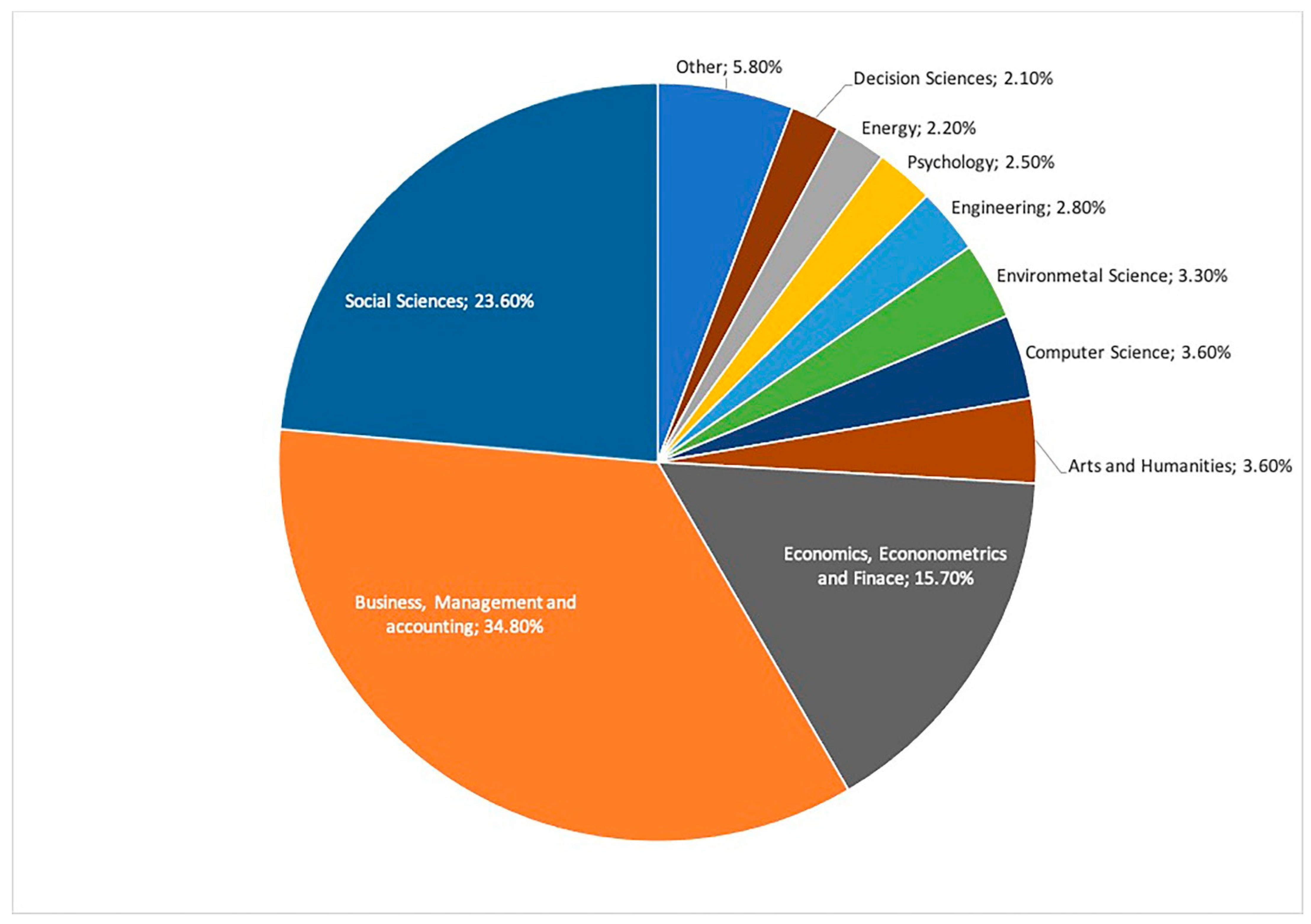
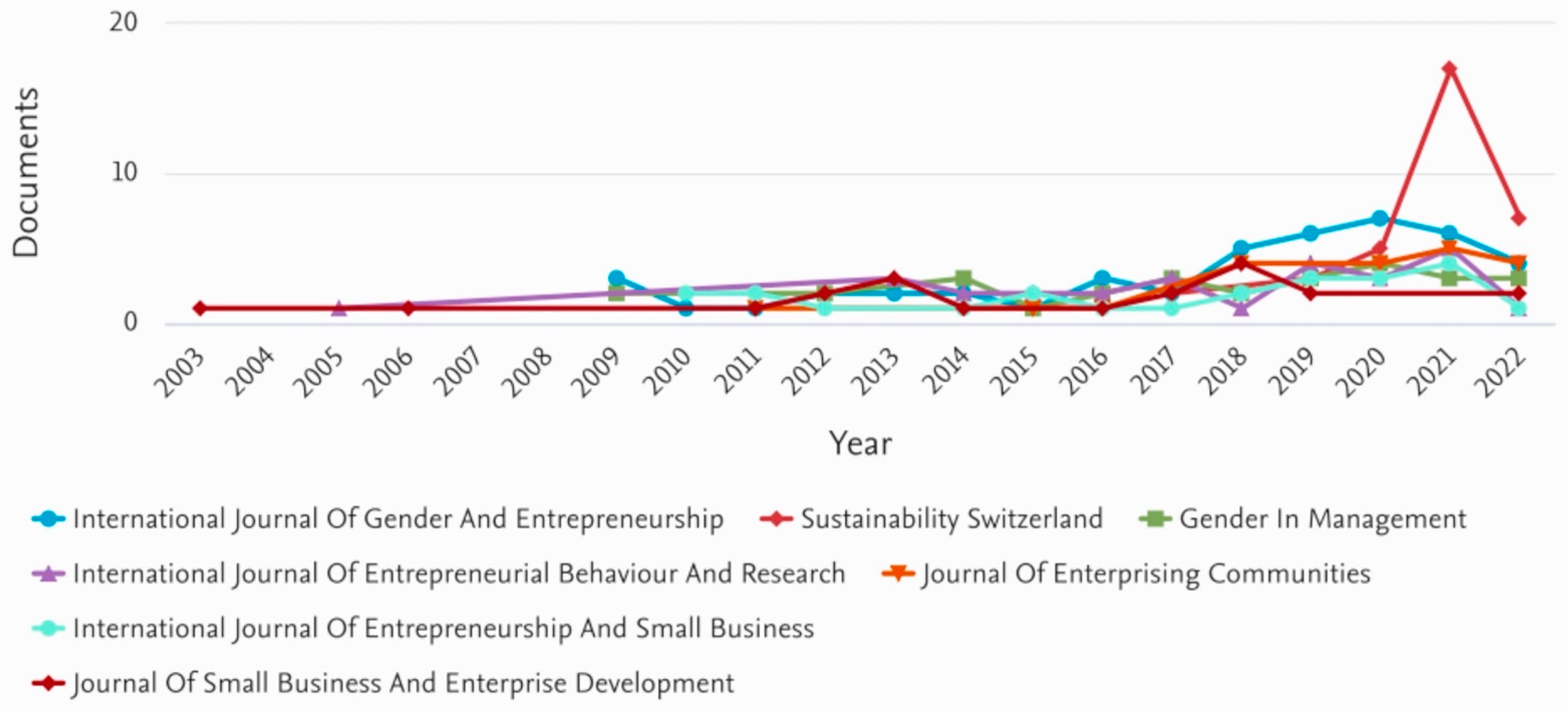
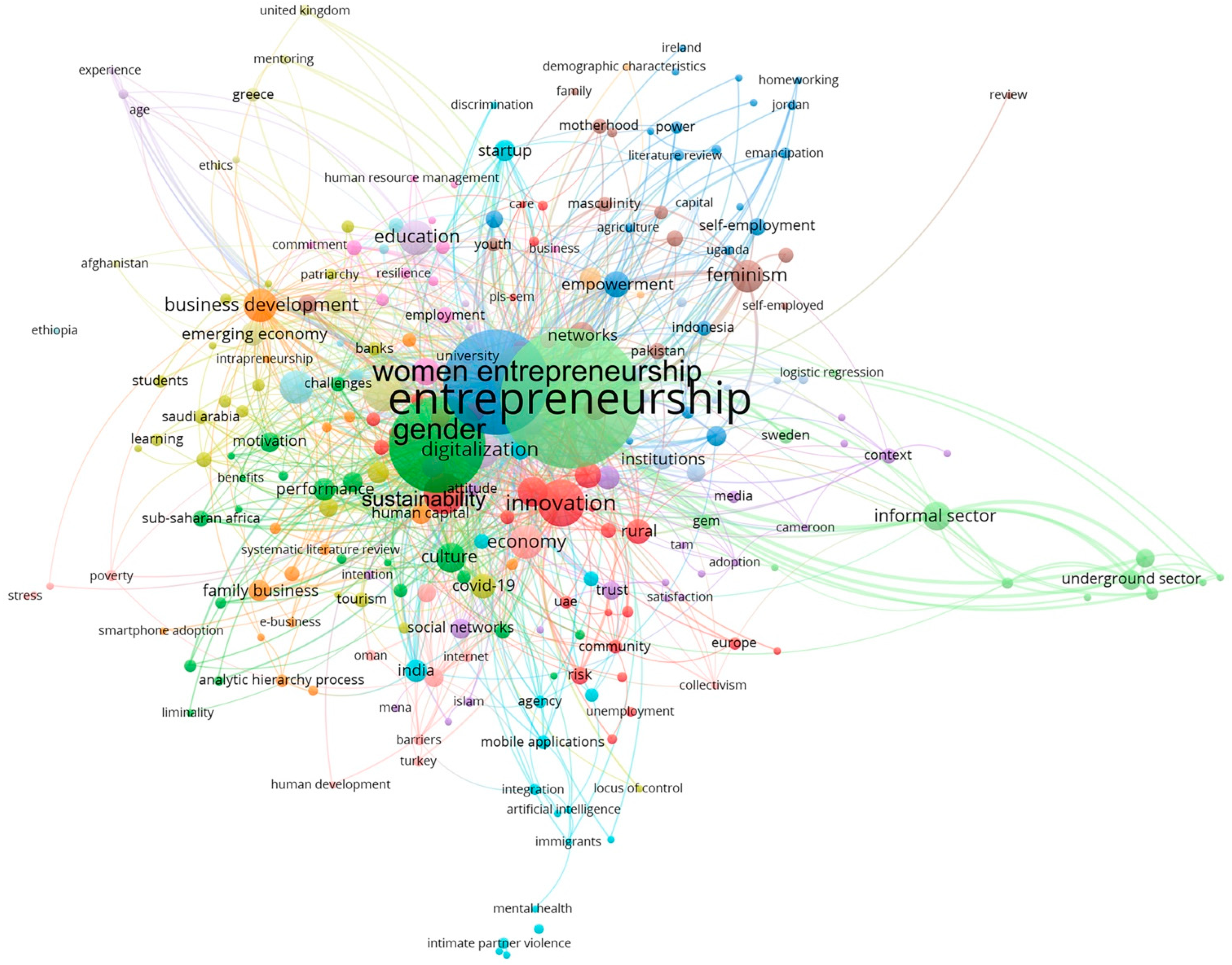
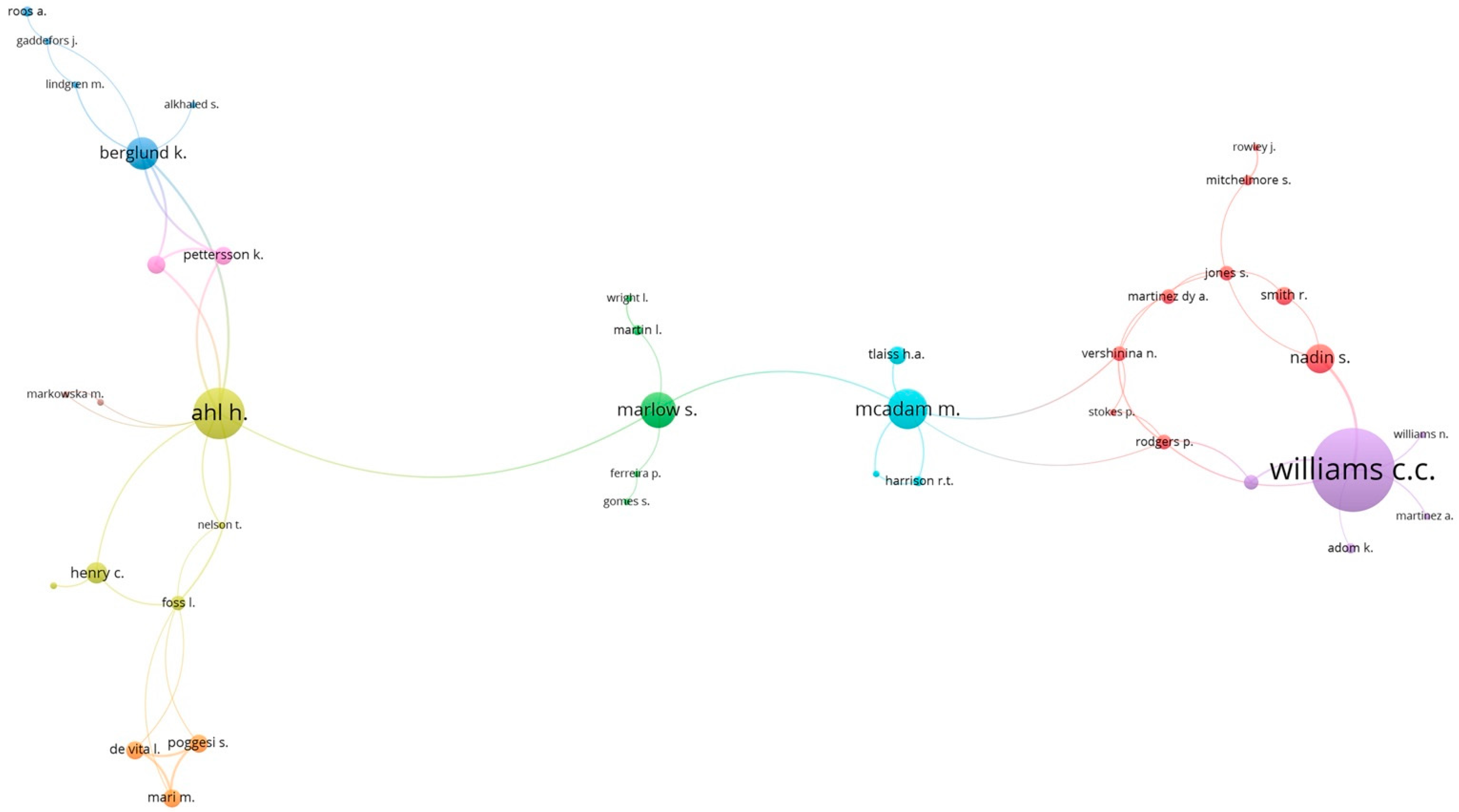
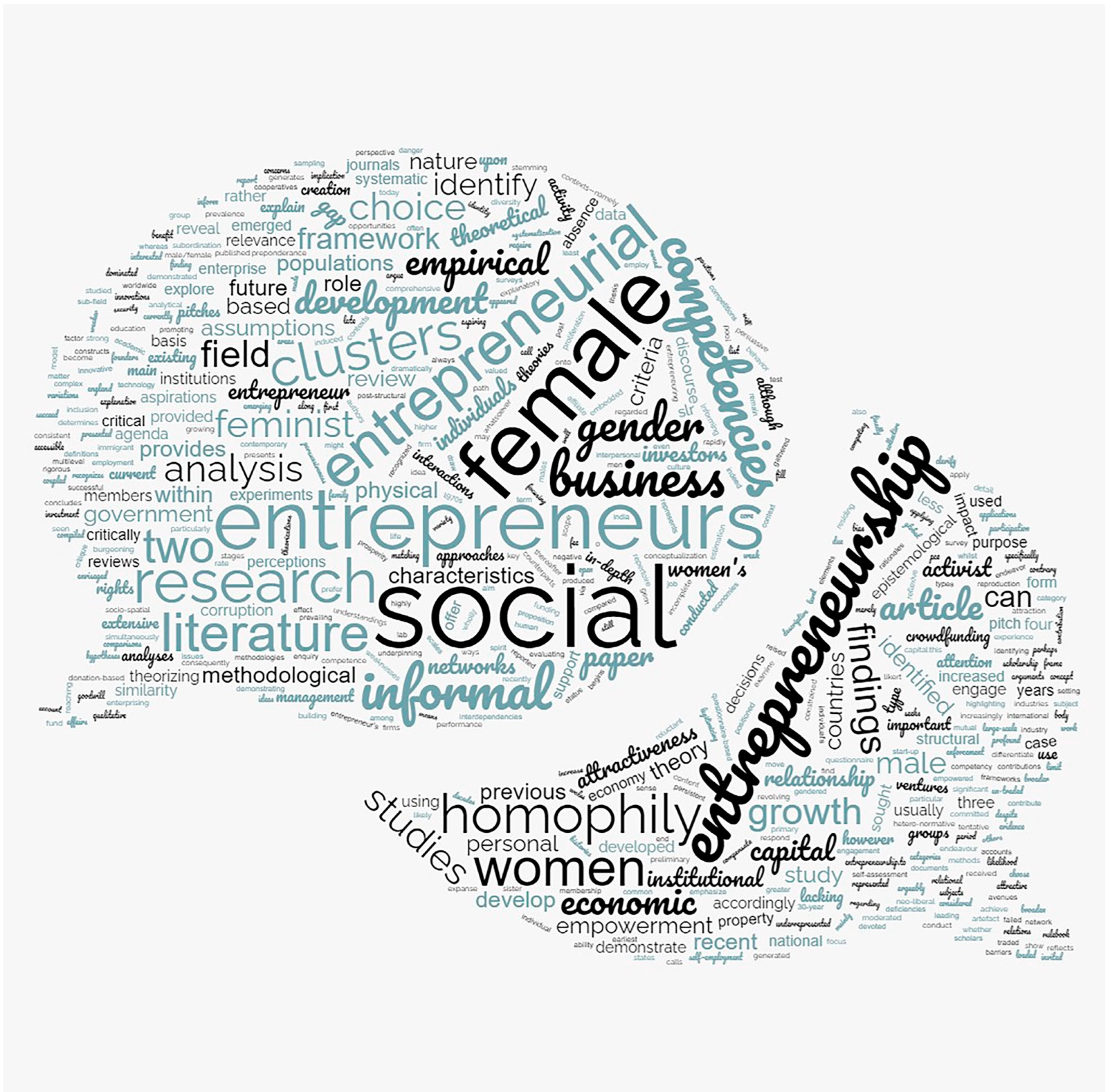

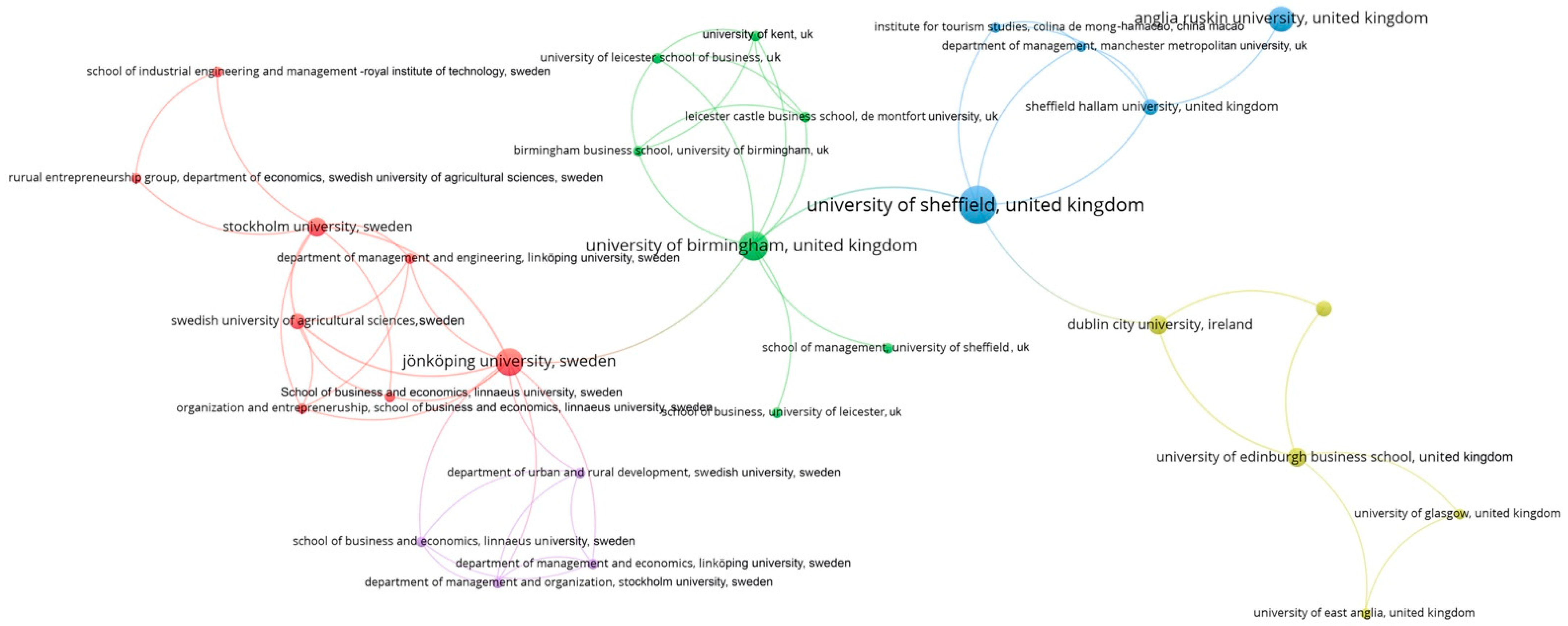
| Citation Report | |
|---|---|
| Publications | 1356 |
| Times cited | 17,434 |
| Citation average per item | 12.86 |
| H-Index | 61 |
| Journals | Journal Impact Report (Scopus, 2022) |
|---|---|
| International Journal of Gender and Entrepreneurship | Q1 |
| Sustainability Switzerland | Q1 |
| Gender in management | Q1 |
| International Journal of Entrepreneurial Behaviour and Research | Q1 |
| International Journal of Entrepreneurship and Small Business | Q3 |
| Journal of Enterprising Communities | Q1 |
| Journal of Small Business and Enterprise Development | Q1 |
| Frontiers in Psychology | Q2 |
| Entrepreneurship and Regional Development | Q1 |
| International Entrepreneurship and Management Journal | Q1 |
| Journal of Business Research | Q1 |
| Journal of Small Business management | Q1 |
| Gender, Work and Organization | Q1 |
| International Small Business Journal Researching Entrepreneurship | Q1 |
| Journal of Developmental | Q2 |
| Small business Economics | Q1 |
| Journal Women’s Entrepreneurship and Education | Q3 |
| Journal of Small Business and Entrepreneurship | Q1 |
| Authors—Year | Articles | Sources | Scopus | Citation |
|---|---|---|---|---|
| (Shinnar et al. 2012) | Entrepreneurial perceptions and intentions: The role of gender and culture https://doi.org/10.1142/S1084946710001683 | Entrepreneurship: Theory and Practice | Q1 | 447 |
| (Estrin et al. 2013) | Which institutions encourage entrepreneurial growth aspirations? https://doi.org/10.1016/j.jbusvent.2012.05.001 | Journal of Business Venturing | Q1 | 383 |
| (Ahl and Marlow 2012) | Exploring the dynamics of gender, feminism and entrepreneurship: Advancing debate to escape a dead end? https://doi.org/10.1177/1350508412448695 | Organization | Q1 | 346 |
| (Henry et al. 2016) | Gender and entrepreneurship research: A review of methodological approaches https://doi.org/10.1177%2F0266242614549779 | International Small Business Journal | Q1 | 256 |
| (Datta and Gailey 2012) | Empowering Women Through Social Entrepreneurship: Case Study of a Women’s Cooperative in India https://doi.org/10.1111/j.1540-6520.2012.00505.x | Entrepreneurship: Theory and Practice | Q1 | 254 |
| (De Vita et al. 2014) | Women entrepreneurs in and from developing
countries: Evidences from the literature http://dx.doi.org/10.1016/j.emj.2013.07.009 | European Management Journal | Q1 | 234 |
| (Anderson et al. 2007) | Entrepreneurial social capital: Conceptualizing social capital in new high-tech firms https://doi.org/10.1177%2F0266242607076526 | International Small Business Journal | Q1 | 208 |
| (Greenberg and Mollick 2017) | Activist Choice Homophily and the Crowdfunding of Female Founders https://doi.org/10.1177/0001839216678847 | Administrative Science Quarterly | Q1 | 177 |
| (Brooks et al. 2014) | Investors prefer entrepreneurial ventures pitched by attractive men https://doi.org/10.1073/pnas.1321202111 | Proceedings of the National Academy of Sciences of the United States of America | Q1 | 172 |
| (Mitchelmore and Rowley 2013) | Entrepreneurial competencies of women entrepreneurs pursuing business growth https://doi.org/10.1108/14626001311298448 | Journal of Small Business and Enterprise Development | Q1 | 154 |
| (Santos et al. 2016) | About Gender Differences and the Social Environment in the Development of Entrepreneurial Intentions https://doi.org/10.1111/jsbm.12129 | Journal of Small Business Management | Q1 | 151 |
| (Dy et al. 2017) | A Web of opportunity or the same old story? Women digital entrepreneurs and intersectionality theory https://doi.org/10.1177/0018726716650730 | Human Relations | Q1 | 146 |
| (Overå 2006) | Networks, distance, and trust: Telecommunications Development and changing trading practices in Ghana https://citationsy.com/archives/q?doi=10.1016/J.WORLDDEV.2005.11.015 | World Development | Q1 | 124 |
| (Rosa and Dawson 2006) | Gender and the commercialization of university science: Academic founders of spinout companies https://doi.org/10.1080/08985620600680059 | Entrepreneurship and Regional Development | Q1 | 122 |
| (Godwin et al. 2006) | Forced to play by the rules? Theorizing how mixed-sex founding teams benefit women entrepreneurs in male-dominated contexts https://doi.org/10.1111/j.1540-6520.2006.00139.x | Entrepreneurship: Theory and Practice | Q1 | 121 |
| (Al-Dajani and Marlow 2013) | Empowerment and entrepreneurship: A theoretical framework https://doi.org/10.1108/IJEBR-10-2011-0138 | International Journal of Entrepreneurial Behaviour and Research | Q1 | 120 |
| (Williams and Nadin 2010) | Entrepreneurship and the informal economy: An overview https://doi.org/10.1142/S1084946710001683 | Journal of Developmental Entrepreneurship | Q2 | 117 |
| (Lafuente et al. 2007) | Regional differences in the influence of role models: Comparing the entrepreneurial process of rural Catalonia https://doi.org/10.1080/00343400601120247 | Regional Studies | Q1 | 117 |
| (Durkin et al. 2013) | Exploring social media adoption in small to medium-sized enterprises in Ireland https://doi.org/10.1108/JSBED-08-2012-0094 | Journal of Small Business and Enterprise Development | Q1 | 115 |
| (Ahl and Nelson 2015) | How policy positions women entrepreneurs: A comparative analysis of state discourse in Sweden and the United States https://doi.org/10.1016/j.jbusvent.2014.08.002 | Journal of Business Venturing | Q1 | 109 |
Publisher’s Note: MDPI stays neutral with regard to jurisdictional claims in published maps and institutional affiliations. |
© 2022 by the authors. Licensee MDPI, Basel, Switzerland. This article is an open access article distributed under the terms and conditions of the Creative Commons Attribution (CC BY) license (https://creativecommons.org/licenses/by/4.0/).
Share and Cite
Rando-Cueto, D.; Jambrino-Maldonado, C.; Iglesias-Sánchez, P.P.; De las Heras-Pedrosa, C. Trends and Evolution of Research on Women’s Entrepreneurship and Communication in the Scientific Literature. Journal. Media 2022, 3, 665-681. https://doi.org/10.3390/journalmedia3040044
Rando-Cueto D, Jambrino-Maldonado C, Iglesias-Sánchez PP, De las Heras-Pedrosa C. Trends and Evolution of Research on Women’s Entrepreneurship and Communication in the Scientific Literature. Journalism and Media. 2022; 3(4):665-681. https://doi.org/10.3390/journalmedia3040044
Chicago/Turabian StyleRando-Cueto, Dolores, Carmen Jambrino-Maldonado, Patricia P. Iglesias-Sánchez, and Carlos De las Heras-Pedrosa. 2022. "Trends and Evolution of Research on Women’s Entrepreneurship and Communication in the Scientific Literature" Journalism and Media 3, no. 4: 665-681. https://doi.org/10.3390/journalmedia3040044
APA StyleRando-Cueto, D., Jambrino-Maldonado, C., Iglesias-Sánchez, P. P., & De las Heras-Pedrosa, C. (2022). Trends and Evolution of Research on Women’s Entrepreneurship and Communication in the Scientific Literature. Journalism and Media, 3(4), 665-681. https://doi.org/10.3390/journalmedia3040044









